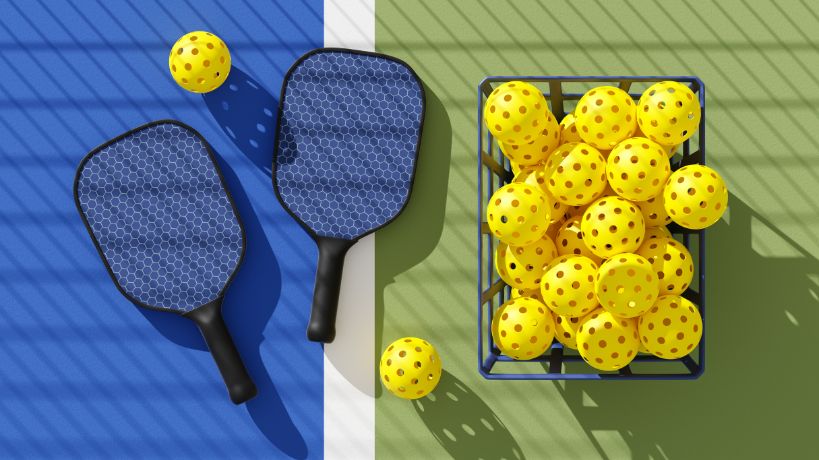Top Tips for Producing a Professional-Grade Backyard Pickleball Court in Your Backyard
Top Tips for Producing a Professional-Grade Backyard Pickleball Court in Your Backyard
Blog Article
Transform Your Outdoor Space: How to Design and Develop Pickleball Judiciaries in Your Residential Yard
Developing a pickleball court in your yard not only adds value to your residential or commercial property however also provides an one-of-a-kind chance for recreation and social communication. The design and building and construction procedure can considerably impact the functionality and enjoyment of the court.

Comprehending Pickleball Court Dimensions
When starting the trip to make a pickleball court in your backyard, it's necessary to realize the specific dimensions that define an official court. A main pickleball court measures 20 feet broad and 44 feet long for both singles and doubles play. Additionally, the court is split right into 2 equivalent fifty percents by a centerline expanding from the standard to the non-volley area, which lies 7 feet from the net on both sides.
The net itself stands at 36 inches high at the sidelines and 34 inches high at the center, guaranteeing a consistent playing experience. Surrounding the court, a minimum of 3 feet of buffer space is recommended on all sides to suit gamer movement and to prevent injuries during gameplay.
For optimal efficiency, think about integrating appropriate surface materials and ample drain solutions when planning your court. The alignment of the court need to additionally be taken into consideration to lessen sunlight interference throughout peak having fun hours. Comprehending these dimensions is important as they will guide the building and construction process and make certain that your yard pickleball court meets main criteria for leisure play.
Choosing the Right Area
Picking a proper location for your yard pickleball court is critical to maximizing both satisfaction and performance. The optimal site must provide a level, degree surface to make certain appropriate drainage and decrease upkeep challenges. Preferably, a space of a minimum of 30 feet large and 60 feet long will suit the court measurements while providing space for risk-free activity around the playing location.
Consider the positioning of the court in relation to the sunlight. Positioning the court east-west can aid lessen glare throughout play, as gamers will encounter the sunlight during early morning or late mid-day matches. In addition, be conscious of any bordering frameworks, such as fences or trees, which may block play or trigger interruptions.
Ease of access is one more vital element; the court must be quickly reachable from your home for benefit and social events. By thoroughly selecting the location, you will create a functional and delightful pickleball court for years to come.
Picking Appropriate Materials
The option of materials is paramount in the construction of a backyard pickleball court, as it directly impacts playability, maintenance, and durability. When choosing materials, it is important to consider both the surface area and the surrounding infrastructure.
For the playing surface, alternatives such as concrete, asphalt, or specialized sports tiles are typically used. Concrete offers excellent longevity and a constant playing surface area, while asphalt can be a more cost-efficient option. Asphalt may call for additional securing to maintain its stability over time. Sports tiles give extra padding and can be personalized in shade, but their installment may be extra complicated.
In terms of bordering infrastructure, secure fencing is essential for maintaining the ball within play and keeping privacy. Chain-link fence is the most preferred option, supplying visibility while supplying required control. Additionally, take into consideration making use of weather-resistant materials for benches and various other devices to guarantee longevity.
Inevitably, the choice of ideal materials need to line up with your spending plan, aesthetic preferences, and details playing problems. Investing in top quality useful source materials will not only improve gameplay yet also decrease long-lasting upkeep prices, allowing for years of enjoyment in your backyard pickleball court.
Designing Your Court Layout
After establishing the best materials for your pickleball court, the next step includes meticulously planning the court design to enhance both performance and pleasure. Begin by choosing a suitable location in your yard, considering variables such as sunshine, wind instructions, and distance to other outdoor attributes. Make sure there is adequate area not only for the court itself yet additionally for surrounding safety areas.
A standard pickleball court gauges 20 feet wide by 44 feet long for both songs and increases play. It is advisable to include extra space around the court-- preferably, at least 10 feet on all sides-- to permit for gamer motion and to stop mishaps. Noting the court dimensions accurately is crucial; make use of chalk or string to describe the location before any kind of building and construction begins.
Include ideal viewing angles, specifically if you plan to delight guests throughout games. In addition, think about the placement of benches or seating locations nearby for spectators and gamers to rest. Thoughtful format preparation will certainly produce an inviting and practical environment that boosts the general experience of playing pickleball helpful resources in your backyard.
Step-by-Step Building And Construction Process
Structure a backyard pickleball court involves an organized building process that makes certain longevity and optimal playability. The initial step is to prepare the website by removing any plants, rocks, or debris and leveling the ground. As soon as the area is prepped, detail your court dimensions-- 20 feet vast by 44 feet long for doubles play-- utilizing risks and string.
Following, dig deep into the location to a depth of roughly 4-6 inches, guaranteeing appropriate drainage is incorporated. Following this, pour a concrete piece, permitting for a smooth and degree surface area, which is necessary for regular sphere bounce.

Final Thought
In conclusion, the transformation of a household yard into a pickleball court offers significant entertainment advantages. The choice of durable products, thoughtful style, and proper building and construction strategies additionally enhance the capability and durability of the court.

Picking an ideal area for your backyard pickleball court is important to making best use of both enjoyment and functionality.After establishing the best products for your pickleball court, the following action includes meticulously intending the court layout to optimize both functionality and enjoyment.Building a backyard pickleball court involves a systematic building and construction process that ensures longevity and optimum playability.
Report this page